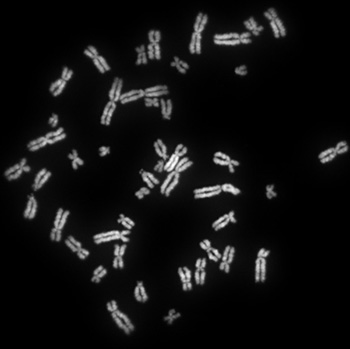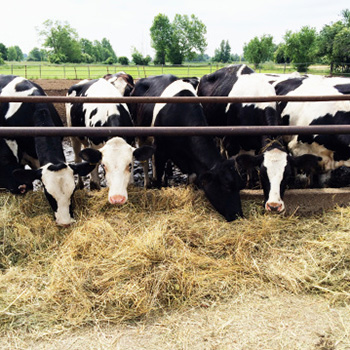The Hardy-Weinberg principle states that in a particular population, the proportions of alleles for each gene do not change unless the population is evolving. When a population is not evolving and its allele proportions are staying the same from generation to generation, it is in Hardy-Weinberg equilibrium. Hardy-Weinberg equilibrium is not a real state that populations attain. It is an idealized, theoretical state in which a population is not evolving at all. Hardy-Weinberg equilibrium provides us with a useful model for understanding how different factors affect allele proportions and population evolution.
If a population were in Hardy-Weinberg equilibrium, we could assume five important points about that population. Check out these slides to learn about the five assumptions of the Hardy-Weinberg equilibrium.
No Mutation
There are no new mutations arising in the DNA (shown above packaged into chromosomes). The alleles for each gene are staying the same. No Migration
There is no migration into or out of the population. The members of the population and the alleles they contain are stable. Large Population
The population is very large. This makes the population less susceptible to random factors that affect allele frequency, such as a flood or earthquake wiping out a large part of the population. Random Mating
Individuals mate randomly. Each individual is equally likely to mate with any other individual of the opposite sex. Individuals do not choose mates based on particular traits (no sexual selection). No Natural Selection
There is no natural selection. No phenotype is more biologically fit than any other. |
When the proportions of alleles in a population are changing, it is not in Hardy-Weinberg equilibrium, and we can assume that one or more of these assumptions is being violated. Each of these assumptions involves a different evolutionary force. When a population is not in Hardy-Weinberg equilibrium, it is because one or more evolutionary forces is affecting the population.
Based on each of the following conditions, figure out whether the population will or will not be in Hardy-Weinberg equilibrium (HWE), or if that condition does not affect HWE.
|
animals are not competing for food
|
will be in HWE
will not be in HWE
no effect on HWE
|
|
male peacocks with large and colorful tails get more mates
|
will be in HWE
will not be in HWE
no effect on HWE
|
|
gene for hair color has multiple alleles
|
will be in HWE
will not be in HWE
no effect on HWE
|
|
geese are leaving their habitat to go south for the winter
|
will be in HWE
will not be in HWE
no effect on HWE
|
Complete





